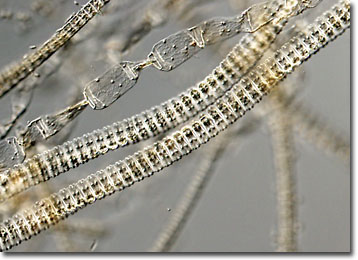Differential Interference Contrast Image Gallery
Zygnema Filamentous Algae
Zygnema is a genus of filamentous algae whose members characteristically possess two star-shaped chloroplasts per cell. Zygnema species are often found alongside other types of algae and may combine to form large greenish-brown mats or clouds in ponds and other still bodies of water.

Capable of proliferating in several different ways, reproduction of Zygnema species is primarily dependent upon environmental conditions. When nitrates and phosphates are readily available, Zygnema generally reproduce vegetatively by fragmenting to create new strands. However, when conditions are less favorable, Zygnema often asexually produce akinetes, spore-like bodies that have very thick cell walls that enable them to survive harsh conditions. In poor environments, members of the genus may also reproduce sexually to create a zygospore that sinks into the sediment at the bottom of the body of water, where it waits to emerge until more propitious circumstances arise.
Large populations of Zygnema can significantly affect the pH level of an aquatic environment. During daylight hours, the hair-like strands of algae produce considerable volumes of dissolved oxygen. At night, however, there is a reverse in the metabolic process and the masses of Zygnema consume oxygen and generate carbon dioxide as a waste product of cellular respiration. When the creation of carbon dioxide in the water is very rapid due to substantial numbers of Zygnema, the pH level changes too quickly for many other aquatic organisms to easily adjust, resulting in stress and aberrant behavior.
